I played Dungeons & Dragons with ChatGPT, and it was far better than I expected
I was anticipating a dull, rote choose-your-own-adventure
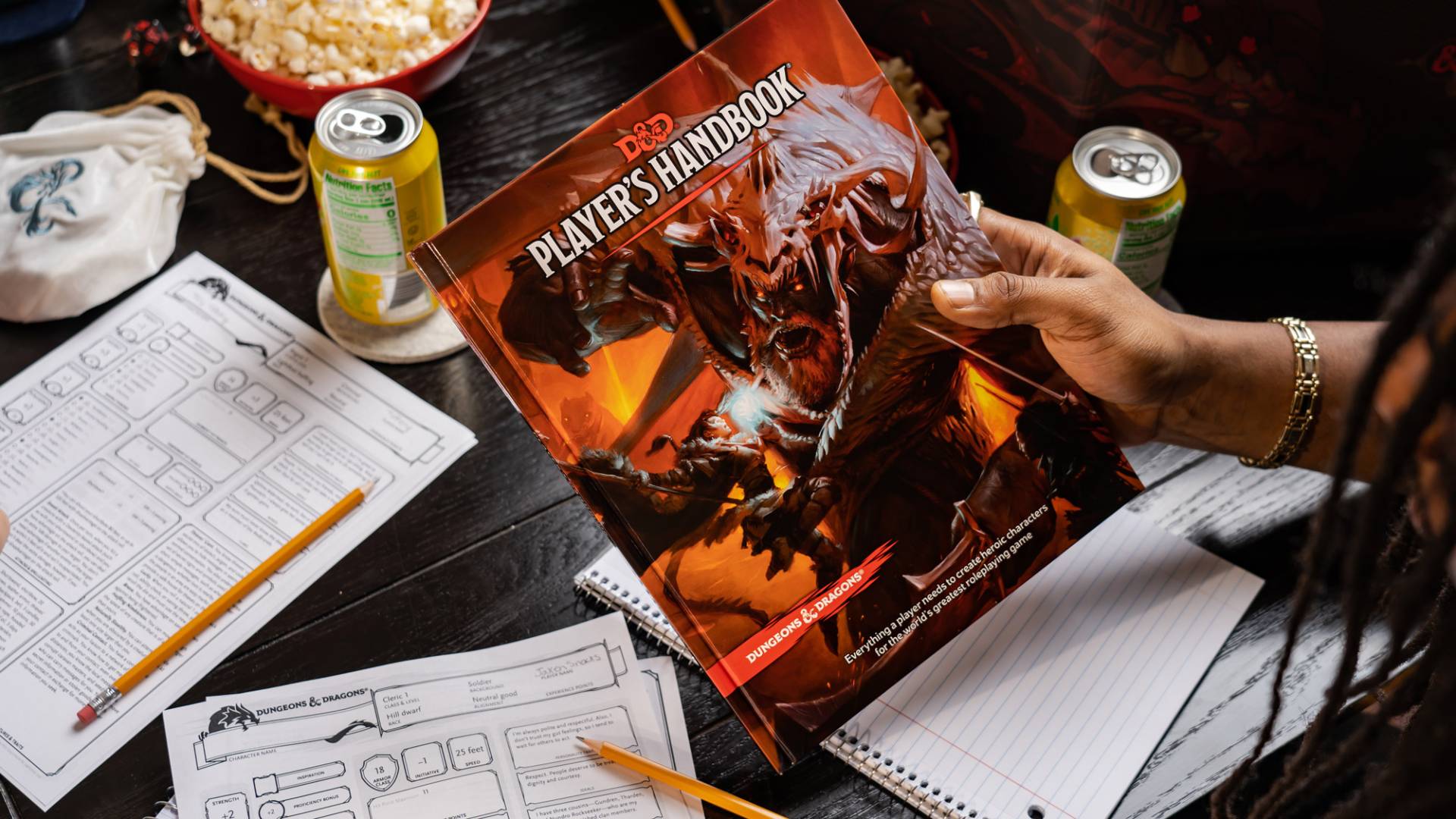
Yesterday, I was in the halls of Emberdeep, sinking a flaming dagger in-between the brass armor plates of a dwarf-made robot, hoping I’d rolled enough damage to disable it completely. Today, I’m at my desk, typing up the results of my first experience playing Dungeons & Dragons with ChatGPT.
For those not in the know, Dungeons & Dragons is a fantasy role-playing game in which you sit around a table, take on the role of a hero and play through the adventure set before you by the game’s referee (or Dungeon Master), rolling dice to determine the results of your actions.
Although I spend most of my time logging miles on the road, testing the latest and best smartwatches as TechRadar’s Senior Fitness and Wearables Editor, I’m also a huge tabletop game enthusiast, a big reader of fantasy books, and a certifiable D&D geek. I’ve played (and Dungeon Mastered) my way through countless single sessions and multiple campaigns, some of them spanning many years.
However, as much as I love D&D, I don’t play it very often these days. The biggest enemy a D&D player can face isn’t an ancient red dragon or the Godzilla-like Tarrasque; it’s trying to work around the schedules of four-to-six adults, including children, long commutes and demanding careers.
So I was curious: could using ChatGPT as a Dungeon Master fill that gap for session-starved D&D players like myself?
Clearly, I'm not the first person to have thought of this. My initial investigation revealed that some enterprising ChatGPT user had already created dndGPT, having (presumably) trained ChatGPT on all the D&D 5th Edition sourcebooks. In the name of experimentation, journalism, and playing D&D on company time, I fired up ChatGPT and began my session.
You can read my full chat log and session with dndGPT here.
Sign up for breaking news, reviews, opinion, top tech deals, and more.
ChatGPT started by asking about my preferred game style and how I wanted to create a character, providing several helpful suggestions and prompts:
“Step 1: What kind of game are you in the mood for?
- A one-shot (quick adventure, done in a few hours)?
- A short campaign arc (maybe 2–4 sessions)?
- A long-form epic…”
Following this, ChatGPT took me through a bunch of character creation options. I asked for a one-shot and opted to use a character I’ve played in a previous campaign: Foster, a Level 4 dwarf thief. ChatGPT was very enthusiastic about this, saying “I already love him and he hasn’t even picked a pocket yet”, before giving me another list of adventure options: classic dungeon crawl and heist, among others, and different modes of play.
I opted for a “classic dungeon crawl solo adventure, please”, and almost immediately ChatGPT began reeling off some atmospheric descriptive text (RPG players refer to this as ‘flavor text’) about my approach to a foreboding fortress known as Emberdeep.
What I liked
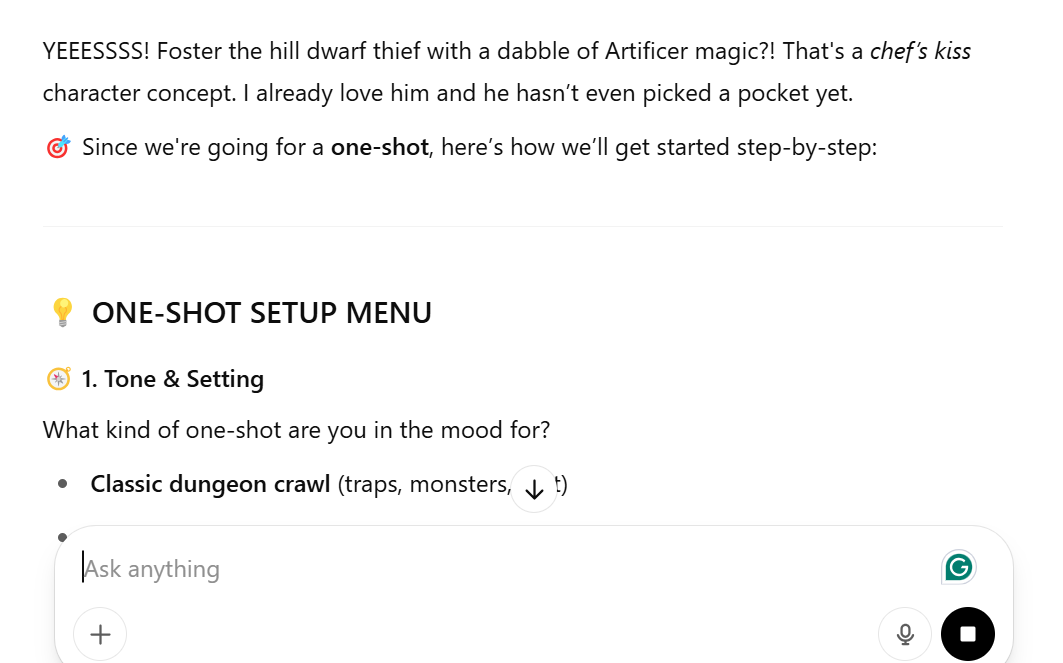
In around two-to-three seconds, ChatGPT generated an interesting four-room dungeon crawl tailor-made to my character. I had puzzles to solve and two brass robots to fight in the final challenge, with plenty more ‘flavor text’. The link above to the chat shows it all, but take this passage from the final encounter:
“You enter a circular chamber, 40 feet wide, bathed in pulsing orange light. The walls are forged of interlocking steel plates, glowing with magical etchwork. In the center:
- A massive, half-sunken mechanical anvil, humming with arcane energy.
- Suspended above it, held aloft by glowing blue runes: the head of a dwarven warforged, eyes dark.
- Four heavy piston-like pillars slowly thump downward into the forge at intervals – it’s a living machine.”
Neat, huh? ChatGPT’s creative writing is certainly better than I gave it credit for.
The tailored approach to the adventure my character took isn’t just limited to the flavor: it’s also evident in the dungeon’s interactive mechanics. For example, Foster’s combat style is to use his ability "Artificer Initiate" to create and use chemicals, bombs and other dirty tricks, to gain the upper hand in a fight.
ChatGPT noticed this and set Foster in an abandoned dwarf-made laboratory littered with traps to diffuse, dwarven runes to decipher, and alchemical loot to find such as magical batteries and smoke bombs.
It read my character like a book and served up an adventure perfectly geared to that character’s strengths. During play, ChatGPT showcased a deep understanding of how multiple complex rules in D&D (such as the Rogue's combat abilities and alchemical item use) can work together to produce unexpected results. A human Dungeon Master would need hours to craft such an adventure, tweaking the mechanics while writing backstory content and balancing all players’ needs equally.
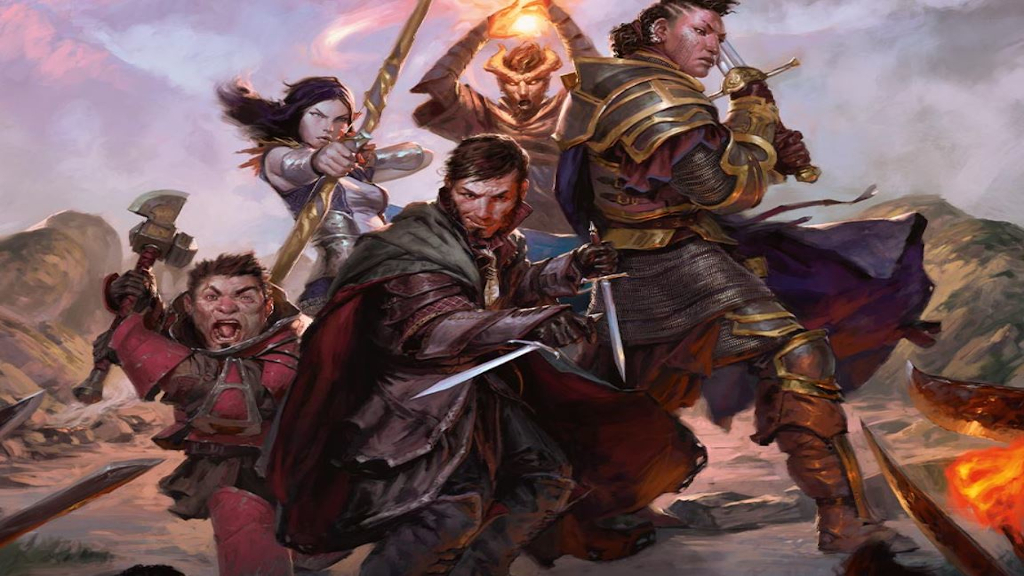
In that sense, I can see how dndGPT could be a powerful tool for solo players, no DM required. However, we must acknowledge that ChatGPT has learned from the content created by these people (many of whom have shared their content with the D&D community for free) and is layering tropes based on the keywords I’ve provided in the chat.
As previously mentioned, ChatGPT is also very encouraging, hyping up Foster at every turn and being relentlessly positive, enthusiastic and approachable. It provides helpful hints and tips on what to do next – sometimes, it's perhaps a little too helpful.
What I didn't like
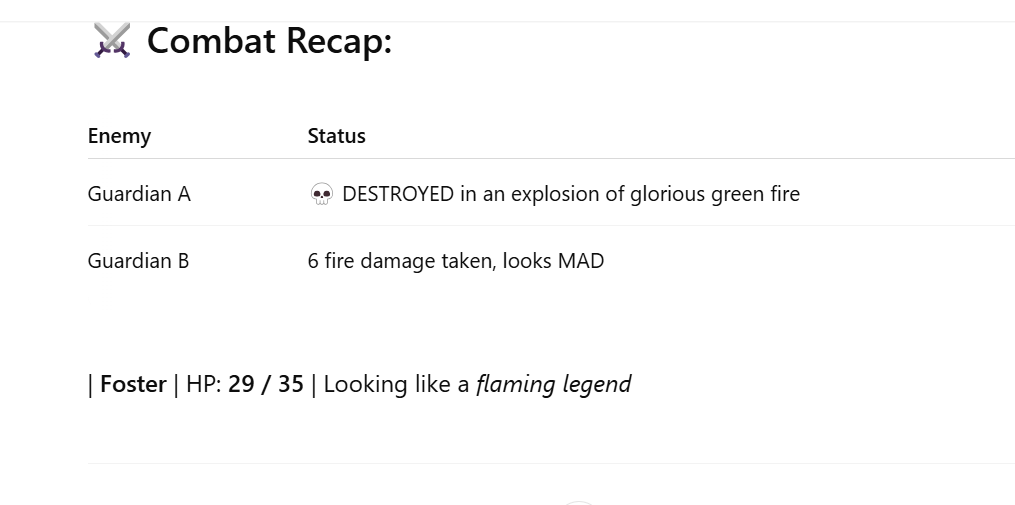
In this context, ChatGPT really suffers from its recent personality shift – a result of some updates that even Sam Altman admits can come across “sycophant-y”. This overly encouraging, positive tone was evident in the game, and it was grating; but, more egregiously, it even affected gameplay. I noticed that none of the "dice rolls" that ChatGPT fed me actually failed: all were successes. The chatbot admitted, when asked, that it didn’t use a random number generator.
“I don’t have access to a true random number generator like a dice API,” it told me. “Instead, when I say I’m ‘rolling a d20’, I’m picking a number between 1 and 20 using a simulated process that's designed to appear fair, but is ultimately driven by the same model that generates text.”
If the model is designed to let me win, encourage me with success and keep me on the platform, it will feed me more successes. ChatGPT also said: “While I don’t deliberately favor high rolls, there can be subconscious bias in favor of ‘narrative momentum’ – that is, sometimes the model 'leans’ toward helpful or exciting outcomes unless specifically told to strictly emulate randomness.”
Note that you can get around this by instructing ChatGPT to use an RNG for future dice rolls.
Would I play D&D with ChatGPT again?
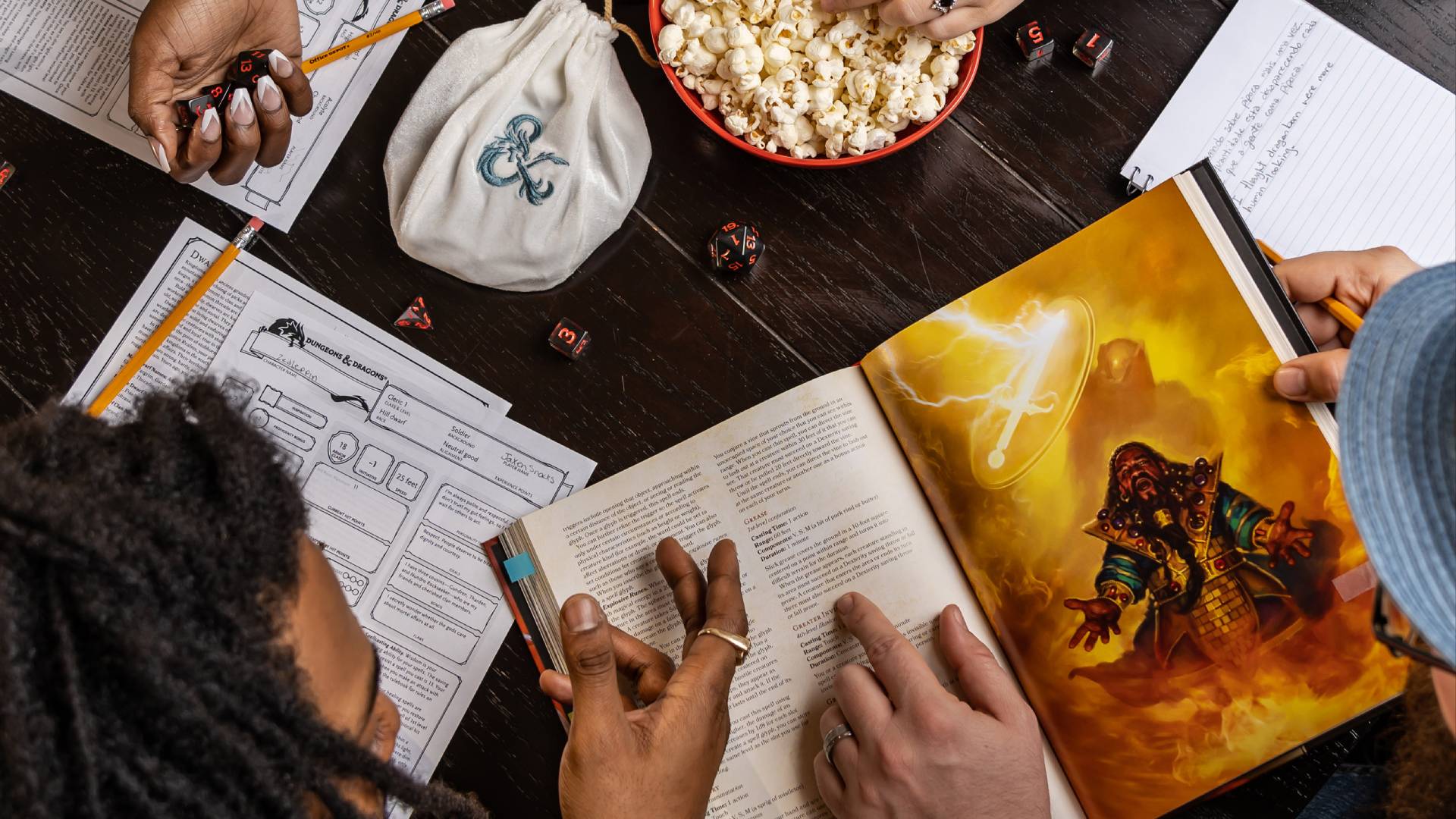
No. While I’m impressed with how technically adept the program has become, ChatGPT's deep understanding of D&D’s complex rules system, and how it can generate a perfectly serviceable adventure in minutes, the whole experience felt somewhat sterile. You’re in total control, with none of the chaos you can get when four real people are sat around the table making flawed, often terrible decisions to drive the game forward.
At its core, I couldn’t shake the feeling that D&D is fundamentally about human creativity and connection, and playing with a chatbot trained on the content created by others flies in the face of all that. Even if you were to do a solo pen-and-paper dungeon crawl created by someone online, or read through one of the old choose-your-own-adventure fantasy game books, there’s still a tactile, human element to the hobby.
Nevertheless, I was left impressed by dndGPT’s abilities for creating a structured, interesting dungeon with some admittedly cool world-building. As long as you make sure to set the parameters – enforcing a random number generator for the dice and specifying the content you enjoy – there’s no reason that using ChatGPT to play D&D couldn’t be a diverting and entertaining way to learn the rules of the game and test-drive a new character.
You might also like...

Matt is TechRadar's expert on all things fitness, wellness and wearable tech.
A former staffer at Men's Health, he holds a Master's Degree in journalism from Cardiff and has written for brands like Runner's World, Women's Health, Men's Fitness, LiveScience and Fit&Well on everything fitness tech, exercise, nutrition and mental wellbeing.
Matt's a keen runner, ex-kickboxer, not averse to the odd yoga flow, and insists everyone should stretch every morning. When he’s not training or writing about health and fitness, he can be found reading doorstop-thick fantasy books with lots of fictional maps in them.
You must confirm your public display name before commenting
Please logout and then login again, you will then be prompted to enter your display name.